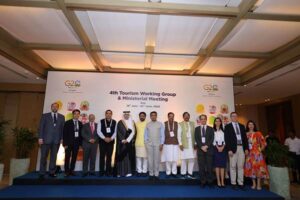Rivers pay for sins of UPPCB officials
UP Pollution Control Board has asked polluting industries in western UP to not discharge untreated effluents in Ganga and its tributaries before Kumbh. No problem if they do it some other time!
Ramdev Bakshi | December 22, 2024 11:49 pm

Photo courtesy: Wikimedia
When governance is reduced to baloney and a string of events, those supposed to run administration sometimes lose perceptiveness to judge their statements. So, the officials in Uttar Pradesh who have the responsibility to protect the environment make the farcical statement that industries that have the potential to discharge into the Ganga, Yamuna, and their tributaries across the state will be closed in phases for a total of 24 days for the ‘shahi snans’ during the Maha Kumbh in Prayagraj from January 13.
UP Pollution Control Board (UPPCB) regional officer Vikas Mishra said the state government has identified several industries in the catchment areas of eight western UP districts—Ghaziabad, Bijnor, Saharanpur, Muzaffarnagar, Shamli, Meerut, Baghpat, and Hapur—which empty effluents in the two rivers and their tributaries. Nine of them are in Ghaziabad alone, a news report in The Times Of India said. https://timesofindia.indiatimes.com/city/noida/closure-of-9-polluting-factories-in-ghaziabad-for-maha-kumbh-to-protect-ganga-and-yamuna/articleshow/115947442.cms#:~:text=UP%20Pollution%20Control%20Board%20regional,two%20rivers%20and%20their%20tributaries.
Notice that Mishra has been unable to discern the incompetence, or worse, of his own government which is implicit in the on-the-record statement he made to the newspaper. It didn’t occur to him that he has been admitting to the fact that his department knows about misconduct by the above-mentioned factories but is unable or unwilling to act against them.
The public admission negates the mandate of the UPPCB. According to the Board’s website, “Principal functions of the Board, as spelt out in the Water Act, 1974, and Air Act, 1981, is (sic) the prevention, control and abatement of water and air pollution. The main effort of the Board is to assist the industries and entrepreneurs to discharge their daily basic obligations to safeguard environment.”
The UPPCB is duty-bound “to assist industries and entrepreneurs to discharge their daily basic obligations to safeguard environment” 365 days a year, not just during the Kumbh period. And even during this period, the Board, as per its own admission, doesn’t intend to exactly work with factory owners to treat effluents; it is just asking them to shut down the factories so that there is discharge of toxic water.
The news report mentioned Union Minister of State for Environment, Forest and Climate Change Ashwini Kumar Choubey’s statement in February that about 402.67 million litres per day (MLD) of industrial effluents by 3,186 grossly polluting industries (GPI) are discharged into the Ganga and the Yamuna in seven states—UP, Uttarakhand, Bihar, Jharkhand, West Bengal, Delhi, and Haryana. Also, about 249.31 MLD is discharged into the Ganga and 153.36 MLD into the Yamuna.
If the UPPCB has done anything since then to end or minimize the flow of industrial effluents in rivers since then, it has not mentioned that on its website. It doesn’t have any press releases.
Last month, the National Green Tribunal (NGT) observed that the water quality in the Ganga in UP is deteriorating because of the discharge of sewage or sullage into the river. Earlier, the NGT had sought compliance reports from various states, including UP.
Later in the month, the green body sought a response from the UP Chief Secretary on the pollution of the Hindon River. “The 400-kilometre rain-fed river, emerging from the Shivalik Hills in Saharanpur and flowing through seven districts supports a population of 19 million people along its banks, but the river has become a toxic channel, receiving over 72,170 kilolitres per day (KLD) of industrial effluents (sic) from 357 industries and 943 million litres per day (MLD) of domestic sewage, with more than 220 MLD remaining untreated due to insufficient infrastructure,” a bench of NGT Chairperson Justice Prakash Shrivastava said.
Also in November, the Supreme Court ordered the Agra Nagar Nigam to pay an environmental compensation of Rs 58.39 crore for polluting the Yamuna with untreated sewage, underscoring the severity of environmental degradation in the river due to municipal negligence.
Interestingly, the top court’s order came in response to any UPPCB report but findings from the NGT’s April order, which documented the failure of existing sewage treatment plants (STPs) in Agra.
It is not that these are isolated incidents; rivers are dying and water bodies are shrinking, getting noxious, or even simply disappearing. There is also something called ‘reverse boring’—at least in western UP. Whereas boring helps lift underground water to the surface, reverse boring disposes of polluted water into the ground by drilling a deep hole. When the contaminated water mixes with ground water, it adds toxicity to aquifers, resulting in health hazards when it is pumped out for drinking and other purposes.
What is more worrying is that now it is not just big factories that are injecting their water into the ground; even housing societies, restaurants, etc., are doing the same.
Evidently, the UPPCB doesn’t seem to be doing its job very successfully. Perhaps, their decision to shut down industries polluting rivers during the Kumbh period is some kind of tribute UPPCB officials are paying to the sacred Ganga. As the famous song says, “Ram teri Ganga maili ho gayee…”





























